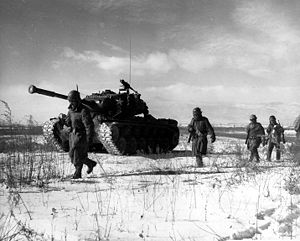| Battle of Chosin Reservoir | |||||||||
|---|---|---|---|---|---|---|---|---|---|
| Part of the Second Phase Offensive of the Korean War | |||||||||
 A column of the US 1st Marine Division moves through Chinese lines during its breakout from the Chosin Reservoir with a M46 Patton medium tank. | |||||||||
| |||||||||
| Belligerents | |||||||||
|
| |||||||||
| Commanders and leaders | |||||||||
| Units involved | |||||||||
| See order of battle | See order of battle | ||||||||
| Strength | |||||||||
| ~30,000[1] | ~120,000[2] | ||||||||
| Casualties and losses | |||||||||
Location within Korea | |||||||||
The Battle of Chosin Reservoir, also known as the Chosin Reservoir Campaign or the Battle of Lake Changjin (Korean: 장진호 전투; Hanja: 長津湖戰鬪; RR: Jangjinho jeontu; MR: Changjinho chŏnt'u), was an important battle in the Korean War.[c] The name "Chosin" is derived from the Japanese pronunciation "Chōshin", instead of the Korean pronunciation.[9][10][d]
The battle took place about a month after the People's Republic of China entered the conflict and sent the People's Volunteer Army (PVA) 9th Corps[e] to infiltrate the northeastern part of North Korea. On 27 November 1950, the Chinese force surprised the US X Corps commanded by Major General Edward Almond in the Chosin Reservoir area. A brutal 17-day battle in freezing weather soon followed. Between 27 November and 13 December, 30,000[1] United Nations Command troops, later nicknamed "The Chosin Few", under the field command of Major General Oliver P. Smith were encircled and attacked by about 120,000[2] Chinese troops under the command of Song Shilun, who had been ordered by Mao Zedong to destroy the UN forces.
The UN forces were nevertheless able to break out of the encirclement and withdraw to the port of Hungnam. Both sides suffered heavy casualties, especially the Chinese, with both battle casualties and non-battle casualties caused by the frigid weather. The withdrawal of the US Eighth Army from northwest Korea in the aftermath of the Battle of the Ch'ongch'on River and the evacuation of the X Corps from the port of Hungnam in northeast Korea marked the complete withdrawal of UN troops from North Korea.
- ^ a b Appleman 1990, p. 24.
- ^ a b Ye 2007, p. 259.
- ^ Appleman 1990, pp. 345–347.
- ^ Appleman 1990, p. 348.
- ^ Xue & Li Part Four 2000.
- ^ Department of Health, People's Liberation Army General Logistics Department 1988, p. 327.
- ^ Appleman 1990, p. 352.
- ^ Roe 2000.
- ^ Tertitskiy, Fyodor (21 November 2017). "Words, words: North and South Korea's differing romanization". NK News. Archived from the original on 6 October 2021. Retrieved 6 October 2021.
- ^ Down in the weeds.
Cite error: There are <ref group=lower-alpha> tags or {{efn}} templates on this page, but the references will not show without a {{reflist|group=lower-alpha}} template or {{notelist}} template (see the help page).
